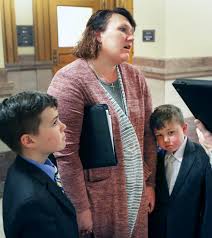
Dozens of landowners and residents voiced their complaints against the wind industry this week at a Kansas legislative committee hearing on a bill proposing restrictions on new wind energy developments in the state.
The property owners and others complained of the effect of wind farms and accused county officials of not standing up to large energy corporations, according to the Topeka Capital Journal.
More testimony is scheduled for Thursday at the capital in Topeka.
Here is how the Capital Journal reported the story:
Amy Brown held her two young sons to her side Tuesday as she fought back tears and lashed out at the company that plans to surround her home south of Hutchinson with massive wind turbines.
She was in the Statehouse for a hearing on a bill that would impose heavy restrictions on new wind energy developments across the state. The law would require a 1.5-mile cushion between residential homes and wind turbines.
Echoing the concerns of those who testified in support of the restrictions, Brown said she fears health problems linked by studies to low-frequency sounds produced by wind generators. If Reno County officials approve a deal with NextEra Energy, she said, her family’s 9-acre property will be in the middle of an industrial wind facility of more than 80 turbines.
“The impact to my children’s overall health is significant enough that our family has talked about living in a camper on the lake to recoup if we can,” Brown said. “We worked very hard to have paid for our home so we can give these children a life that’s better than what we even had, and it’s sincerely being taken from us.”
More than 50 observers packed the House Energy, Utilities and Telecommunications Committee hearing as property owners and others complained about the effect of wind farms and accused county officials of failing to stand up to large energy corporations. Those companies will have a chance to counter in a hearing scheduled for Thursday.
Rep. Randy Garber, R-Sabetha, said he introduced House Bill 2273 on behalf of his constituents. The legislation requires new wind turbines be at least 7,920 feet from a residence, 15,840 feet from airports and parks, and 1,500 feet from property lines.
Additionally, the turbines must be equipped with radar technology that can detect nearby aircraft and activate a warning light, rather than leave the light on all the time.
Counties could extend the setback limits, and property owners could waive their rights. The law would ban nondisclosure terms for property owners who enter into an agreement with developers.
Lawmakers heard from residents in Nemaha, Brown and Reno counties who said “unregulated wildcatting” energy companies take advantage of local officials who are unprepared for negotiations.
Rep. Jim Gartner, D-Topeka, said residents should direct their complaints toward county boards who are responsible for the “dereliction of their duty.”
“If these people aren’t doing the job they’re supposed to, throw them out of office,” Gartner said.
If all local officials acted appropriately, said Rep. Joe Seiwert, a Pretty Prairie Republican and chairman of the committee, legislators wouldn’t need to be here.
Brown said NextEra offered a 2,000-foot setback while threatening to pull the development if the county stalled negotiations.
Lori Menold, a nurse in Nemaha County, offered testimony in support of health concerns associated with wind turbines. She said landowners who agree to a lease are asked to sign a waiver for any problems relating to “audio, visual, view, light, flicker, noise, shadow, vibration, air turbulence, wake, electromagnetic, electrical and radio frequency interference.” She viewed the language as an admission that turbines cause problems.
Referencing several studies, she said the noise from turbines leads to complaints of sleep disturbance, headaches, dizziness, vertigo and ear pressure. Those symptoms in turn can lead to cardiovascular disease and diabetes and other ailments, she said.
“In terms of wind energy, when the pros and cons are evaluated, the adverse effect on people’s health is far from small,” Menold said. “These adverse health effects can be significantly minimized if there are safe setback distances that are enforced.”
To place the size of a turbine in perspective, he compared it to the size of the Statehouse, which is about 325 feet tall. At 500 or 600 feet tall, a wind turbine would tower over the Statehouse with a wingspan the size of a Boeing 747. He asked lawmakers to imagine a jet spinning from the top of the dome at 15 turns per minute.
Brown and Nemaha counties allow these structures within 600 feet of the home of someone who declines an agreement with the developer, he said.
“Nobody wants a wind turbine that close to their home,” Ackerman said. “Nobody.”





